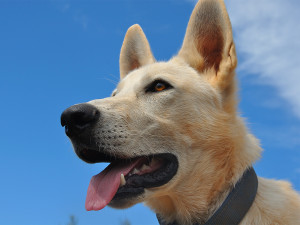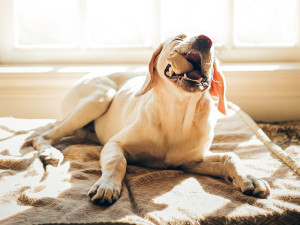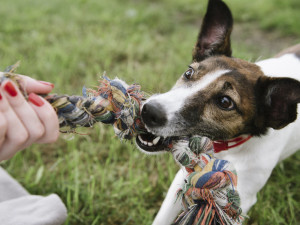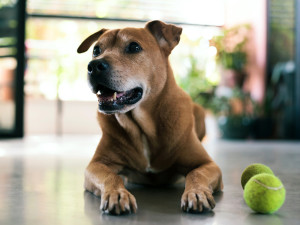Chew on This: A Guide to Safe and Not-So-Safe Dog Bones
Two experts—a veterinary dentist and internist—rate the most popular dog bones.
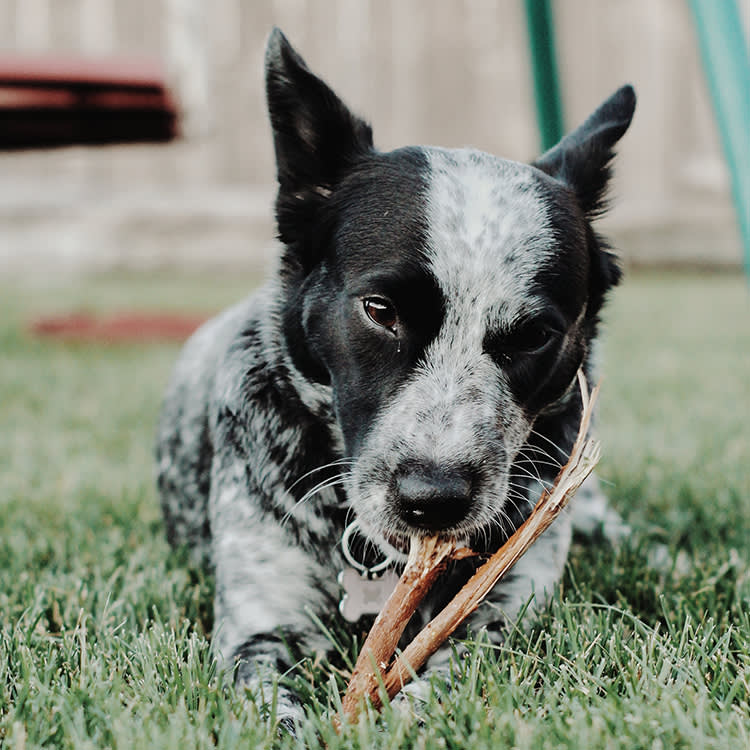
Share Article
For years, dogs and bones have been as synonymous as peanut butter and jelly: They just go together, no questions asked. But the reality is, unlike the classic sandwich, it’s not that simple.
“As the bone aisle gets more crowded, it’s become harder and harder for people to identify safe ones from not-so-safe ones,” says Dr. Daniel Carmichael, a board-certified veterinary dentist at the Veterinary Medical Center of Long Islandopens in new tab in New York. A safe one, from a dental-health perspective, counts as a bone that helps cleanse the teeth via chewing, but isn’t so hard that it causes a dental fracture (aka, a cracked tooth).
“Dog teeth are hollow like ours. When a dog breaks a tooth, it’s not only painful, but it also exposes the root so that bacteria can get inside and lead to infection,” explains Dr. Carmichael. Several times a week, he sees a dog who has suffered a dental fracture due to chewing on a bone — which, for scale, has added up to “probably 10,000 dogs over the course of my career.”
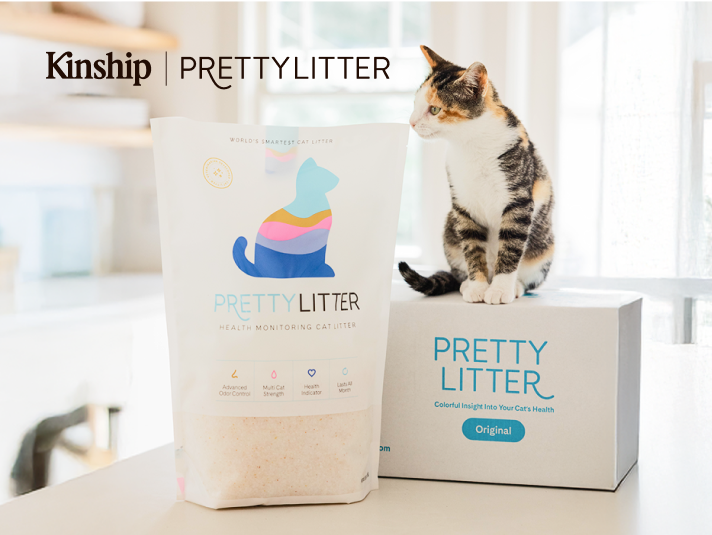
Save on the litter with color-changing tech that helps you better care for your cat.
Then there’s the gastrointestinal (GI) aspect: Many bones present digestive hazards, especially when they can be torn into large and ingestible chunks, says Dr. Yuri Lawrence, PhD, a veterinarian and mobile internist in Austin, Texas. If a large piece is ingested, it could get stuck in the esophagus, causing breathing problems, or in the GI tract, which can create inflammation and invite vomiting, loss of appetite, and serious discomfort. Often, surgery is the only option.
With the help of our experts, Kinship put together a guide to navigating the bone aisle, separating the safe from the downright dangerous choices out there. And, word to the wise (those who, like me, throw a guilt-bone on their way out the door): Only give your dog a bone when you’re home to monitor them. Not only will it help you learn your dog’s (potentially hazardous) chewing habits, you’ll also thank yourself in the event that something bad happens.
Safe dog bones
Pig ears
In both the dental and digestive departments, pig ears fly high. (They’re also a sustainable option). Because the texture is relatively thin compared to most bones, there’s less risk of your dog cracking a tooth while chewing on it, Dr. Carmichael says. And when it comes to GI problems, Dr. Lawrence has yet to have dog come in for an internal issue from eating a pig ear. “As long as it seems like the right size for your dog” — as in, something they can properly chew up — “you shouldn’t have to worry.”
Bully sticks
Similar to pig ears, bully sticks — which are actually dried, cured bull penis, BTW — are generally safe on the oral front, because they soften as they’re chewed, says Dr. Carmichael. The curled sticks are also hard to snap in half, says Dr. Lawrence, making them less likely to be swallowed in large pieces (though he has seen it on occasion).
It’s worth noting that, especially if you have an overweight pup on your hands, bully sticks aren’t the lowest-cal option: One study revealedopens in new tab that the average six-inch stick packs 88 calories (for reference, that’s about nine percent of a 50-pound dog’s daily calories). But if you’re looking for a sustainable option that’s relatively long-lasting and weight isn’t a concern, bully sticks are a great choice.
Proceed with caution
Dental bones
Dental bones are dog treats that have been specially crafted to promote oral health, particularly by reducing plaque or tartar buildup on teeth. “Every year, more brands show up on the Veterinary Oral Health Council’s radar, which is the organization that researches and vouches for specific products to see how safe and effective they really are,” says Dr. Carmichael, who recommends checking out their website (VOHC.orgopens in new tab) before shopping.
One Journal of Animal Science study foundopens in new tab that these chews may help slow the development and/or progression of periodontal disease when provided after mealtime. But some brands are better than others, says Dr. Carmichael, and often the anti-plaque/anti-tartar benefits come from the dog’s actual chewing more so than the bone’s chemical makeup. One big-name brand he (and the VOHC) recommends to patients: Greeniesopens in new tab.
The only reason this category falls on the caution list is that some dogs have been known to swallow them whole, says Dr. Lawrence, perhaps because the smaller size and softer texture can seem more treat- than bonelike. But if you’ve watched your dog actually chew them, you’re probably in the clear.
Yak Cheese
A relative newcomer to the pet-treat world, yak cheese bones hail from the Himalayas, where yaks (similar to oxen) roam free. There isn’t a ton of research behind them yet, but one studyopens in new tab suggests that the milk yields a healthier fatty-acid profile than dairy milk, which could be why they’re increasingly popular on the shelves. Another study (in mice, mind you) found that yak milk could improve bone mass and bone mineral density — a potential upside if you have a senior dog at home. Even better: Most of the lactose gets removed during processing, so the cheese is unlikely to affect dogs with sensitive stomachs, as long as you offer it in moderate amounts.
Neither vet we interviewed had much experience with these bones (take that as a good sign), but the American Animal Hospital Association cautions they can lead to broken teeth because they are hard and block-like. Yak-cheese bones, however, get high reviews on Amazon for being a long-lasting option for active chewers with sensitive stomachs. Find one that uses only whole ingredients (typically yak milk, lime, and salt). And, pro tip: When the bone is gnawed down to a couple of inches, throw it (wet) into the microwave for 60 seconds to turn it into a chewable cheese puff to prevent choking.
Dangerous dog bones
Rawhides
Is there any dog treat more controversial? There have been several recalls on rawhides — bones made from tanned cow hide — over the years, including a major oneopens in new tab in 2017, either due to a salmonella outbreak or possible chemical contamination during the manufacturing process.
Potential contamination isn’t the only risk factor: There have been countless reports of dogs suffering life-threatening abdominal blockages from ingesting the hide, which can swell up to four times its size in a dog’s stomach, making it impossible to pass. There are other reports of dogs choking.
What’s worse, a 2020 studyopens in new tab found that two of 10 dog chews labeled “rawhide-free” were, in fact, not rawhide-free (they contained some of the same components that designate a rawhide classification). And even bones labeled “natural” and “easily digestible” are sometimes treated with weird chemicals despite containing natural ingredients, says Dr. Lawrence, adding “there’s really no such thing as easily digestible, because any bone that can be ripped into smaller pieces can cause problems.”
Plastic bones
Durable, inedible bones might seem like a brilliant option for a dog with a sensitive stomach or incessant chewing habit, or the budget-conscious pet owner. But they are a nightmare for veterinary dentists.
“If you think about how hard you could bite on something if you wanted to and multiply that about eight times, that’s how hard a dog can bite,” says Dr. Carmichael. Plastic bones have no give when your dog sinks their teeth into them, which means breaking a tooth, particularly a back one, is very likely.
They’re rarely ingested, so not too much of a concern for an internist — but it has happened, says Dr. Lawrence, recalling a lawsuit a few years back.
Raw bones
We’re talking femur bones, marrow bones, and the like. While a studyopens in new tab in the Australian Veterinary Journal found raw beef bones to be helpful for reducing dental plaque without GI issues, both vets say they’ve seen more problems from these than any other kind of bone.
From a dental perspective, real animal bones are much too hard for a dog to chew on regularly and never have a tooth problem, says Dr. Carmichael. On the internal front, not only can a sharp piece of the bone be ingested, but these bones can also be chewed into a fine dust that forms a paste inside your dog’s GI tract. When the paste enters the colon, it dries out like a brick, preventing your dog from pooping.
Antlers
“A deer, elk, and really any other kind of antler is way too hard for a dog’s teeth,” says Dr. Carmichael, noting that they might seem like a clean and sustainable alternative to other bones on the market, but will likely cost your dog a dental fracture.
The final takeaway? Most dogs will happily gnaw on any bone you throw them, but stick to the expert-recommended ones and it will save your pup a cracked tooth or stomach obstruction (and you a hefty bill).
References:

Marissa Gainsburg
Marissa Gainsburg is a writer, editor and content strategist who recently traded East Coast humidity for West Coast waterfalls (and wildfire smoke). She lives in Portland, Oregon, with her thru-hiker boyfriend (how cliché) and their freakishly intelligent Aussie, Miley. She previously covered all things wellness and lifestyle as the features director at Women's Health. Her work has also appeared in Cosmopolitan, SELF, and Men's Health.
